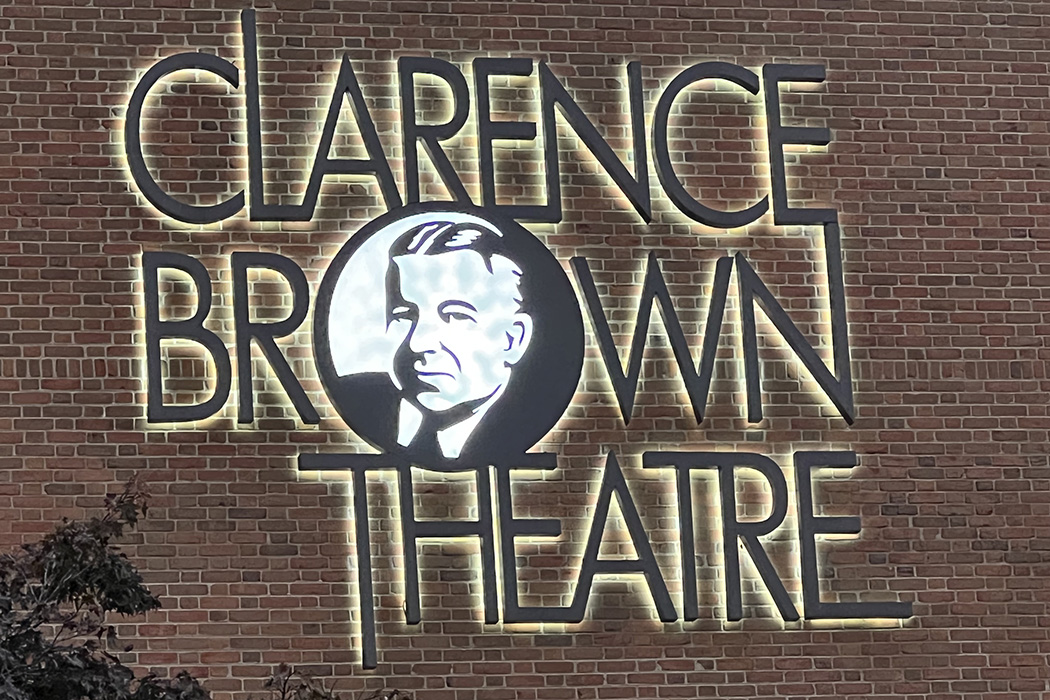Upcoming at Clarence Brown Theatre is a production of Inherit the Wind, the 1955 Jerome Lawrence/Robert E. Lee drama that was inspired by the most important trial of the 20th Century, the Scopes Monkey Trial.
The play opens for two previews on Wednesday and Thursday, February 12/13, with an opening night on Friday, February 14. The play’s run continues through March 2 – evenings at 7:30 PM, Sunday matinees at 2:00 PM. (No performances on Mondays and Tuesdays, except Tuesday, February 25). Tickets and Information
Katie Lupica, director of this CBT production, answered some questions about Inherit the Wind and the CBT production on this, the 100th anniversary of the famous trial.
• • • • • •
Q: While there are always a number of factors that affect the selection of plays for a theatre season, the selection process for Inherit the Wind must have seen some unusually compelling arguments, like—the history behind a real Tennessee event, the continuing science vs. religion debate, and the need to be true to the playwrights’ intent. Recognizing that the programming of theatre seasons occurs as much as a year in advance, what were some of these factors that were considered in selecting Inherit the Wind?
Katie Lupica: The centennial of the Scopes Trial was indeed central to our programming decision. We’ve been collaborating with our divisional dean in the College of Arts and Sciences for two years to bring this production to life, anchoring a rich year of programming including lectures, panels, and special events to honor the 100th anniversary.
It helps that both the historical events and Lawrence and Lee’s script remain so compelling. The play wrestles with questions that feel quintessentially American: the balance between tradition and progress, the relationship between individual conscience and community values, the roles of education, faith, and justice in democracy. These themes resonate as much today as they did in 1925 at the trial and in 1955 at the play’s premiere.
The play’s local significance makes it especially fitting for Clarence Brown’s current motto: “Your Theatre, Your Stories.” While other theaters around the country have produced Inherit the Wind recently, none share our geographical proximity to the historical events that inspired it. Presenting the play here in Tennessee adds immediacy, sensitivity, and pride to our portrayal of the events and characters.
We didn’t know this when programming the play, but It just so happens that one of our actors, Brian Robinson who plays the Reverend, grew up in Dayton, TN. His father played the same role in a production in the historical courthouse when Brian was a teenager — and even had a summer job “curating” the local Scopes museum. During rehearsals for our production, Brian and his family hosted our cast for a field trip to see the courthouse, town, and museum, and it was so special for all involved to be “in the room where it happened.”
• • • • • •
Q: The playwrights, Jerome Lawrence and Robert E. Lee, were careful to broaden and generalize their premise, clearly indicating in their program note that audiences should not take the play as a factual account, a history, or even merely as a debate on evolution. Instead, the “freedom to think” is a paramount angle in their dialogue. Has this affected the approach that either you or the actors have taken?
Katie Lupica: Absolutely. Lawrence and Lee didn’t write a documentary – they write in a mode more akin to a Shakespearean history play, even going so far as to rename their characters. William Jennings Bryan and Clarence Darrow become Matthew Harrison Brady and Henry Drummond, characters who, as the playwrights note, “have life and language of their own.” We’ve embraced their vision of the play as an American parable. While our entire team has done significant research into the historical events, we’ve given ourselves the same creative freedom the playwrights took to serve the larger story.
I love how this play illuminates our collective humanity rather than lecturing about right and wrong. The brilliance of Lawrence and Lee’s work lies in suggesting that enlightenment comes not from choosing sides, but from wrestling with complexity — not “either/or” but “both, so then what?”. Our production emphasizes this idea in our embrace of paradox and simultaneous truth wherever possible, rather than one-sided portrayals of heroes and villains.
You will see this approach most dramatically in the play’s famous courtroom confrontation. When Drummond gets Brady on the witness stand, we’ve taken care not to approach it as a takedown, but rather as two men with enormous respect for one another, ardently arguing their convictions and navigating personal ramifications in real time. When Brady slips up, it is not because he is fundamentally mistaken or ignorant, but because he overreaches in hubris. He is a cautionary tale of the brittleness of absolute certainty—not a punching bag. Our hope is that everyone in the audience will be able to relate to and feel the humanity on all sides of the issues involved.
• • • • • •
Q: The playwrights’ notes conclude “It is not 1925. The stage directions set the time as ‘Not too long ago.’ It might have been yesterday. It could be tomorrow.” While audiences may accept this suggestion, the visual aspects of staging generally require a more specific direction, even if it is a metaphorical one. Could you comment on how this has affected your physical production vis a vis the set and props?
Katie Lupica: Our creative team has embraced this concept whole-heartedly, developing our own version of what the playwrights called “factual fiction” in our storytelling. Rather than anchoring ourselves strictly in 1925, we’ve created an intentionally fluid world that blends elements from both the time of the trial and the 1950s when the play was written. This artistic choice mirrors how we often remember the past—in evocative fragments rather than precise detail.
You’ll see this playful, intentional blend everywhere in our production. The costume designs play with silhouettes from both eras, creating a timeless yet nostalgic feel. Our scenic design abstracts and reimagines the small-town Tennessee setting, while our projection design adds layers of visual poetry to the storytelling. Even our sound design, featuring an original score, helps tune our ears to an era that feels both historical and immediate. There is also a lot of color in this world, representing the fictional Hillsboro as a vibrant forward-looking community.
This approach does more than just solve design challenges—it supports the playwrights’ vision of a story that transcends its historical moment and it proactively disrupts stereotyped expectations. By creating a world that exists somewhere between memory and reality, we invite audiences to see themselves and their own time reflected in these enduring questions about faith, science, and the freedom to think.
• • • • • •

Q: One naturally attaches the reality of the Scopes Trial to the play’s theatrical demands. How has this affected your casting of the major roles?
Katie Lupica: It affected the casting of all roles! It is rare in professional theater to be able to stage democratic ideals at a democratic scale, but thanks to our unique dual mission at Clarence Brown and UT, we can give this play the expansive cast it craves. Our ensemble of 39 actors (remarkably, just over half the size of the Broadway premiere’s 65-person cast!) creates the vibrant world of a community—not just a handful of influential players—grappling with questions that will define its future.
At the center of this dynamic ensemble are two beloved Clarence Brown veterans—Jed Diamond as Drummond and Terry Weber as Brady. Collaborating with these seasoned actors to bring titanic characters to life has been thrilling in rehearsal, and audiences are in for an unforgettable experience when they hit the stage.
Surrounding Jed and Terry is an incredible roster of talent—UT faculty members, MFA acting students, local and regional guest artists, and promising undergraduate performers. Some portray historically-inspired figures like Cates (the defendant), Hornbeck (an acerbic Baltimore journalist), and Brady’s devoted wife Sarah. Others bring to life Lawrence and Lee’s fictional creations, including Rachel (Cates’s conflicted love interest), Reverend Brown (her fiery father), and Meeker (the court’s lovable bailiff).
These characters are only the beginning of people you will get to know and love over the course of the story. In casting all of these roles, we sought to create a community that straddled historical accuracy and modern relatability, and our work together has surpassed even these ambitious expectations. Each ensemble member adds immeasurably to the whole.
• • • • • •
Q: As audiences leave the theatre after Inherit the Wind, one would expect to overhear a wide range of conversations on biology, religion, and history painted by what they’ve just experienced and tinted by the current state of American politics. Do you expect any surprises in this regard? Isn’t this what every director hopes for?
Katie Lupica: Through every choice in this production—from design to performance—we’ve worked to ensure that this story isn’t safely contained in the past but continues to resonate with the hard questions of democracy that we still navigate today. While audiences might arrive expecting a familiar courtroom drama about science versus religion, they’ll discover something more: a deeply human story about how communities navigate change, how individuals find their voice, and how we all struggle with questions of certainty and doubt. Brady’s tragic fall comes from his certainty, so it would be a mistake to replace his absolutes with any of our own about “the right side of history.” Instead, the play offers an invitation to embrace ongoing struggle with difficult questions rather than seeking easy answers.
While Drummond may be the play’s most vocal champion of free thought, some of the story’s most moving moments come from other characters who show us what that struggle looks like on a personal level. We hope audiences leave the theater not just debating ideas, but carrying with them the emotional experience of watching real people wrestle with history in the making, just like we do in our own time.
• • • • • •






